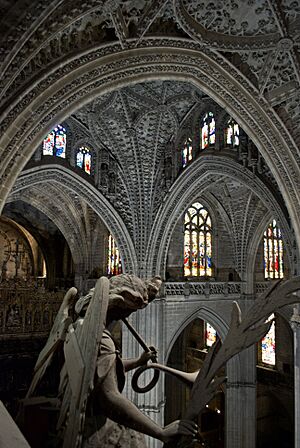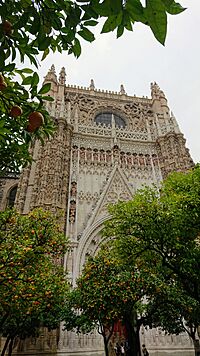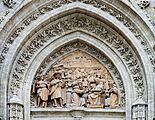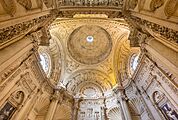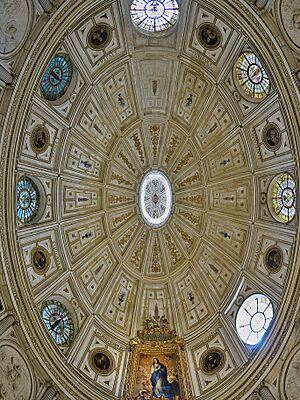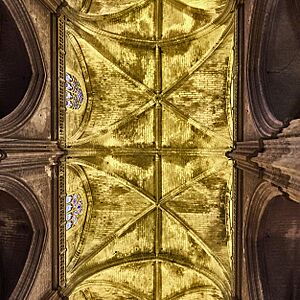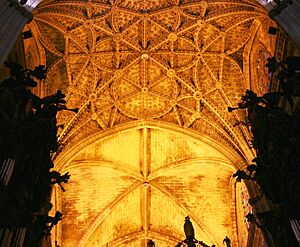Seville Cathedral facts for kids
Quick facts for kids Seville Cathedral |
|
|---|---|
| Cathedral of Saint Mary of the See Catedral de Santa María de la Sede |
|
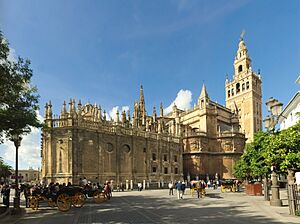
View of the southeastern side of the Cathedral
|
|
| Location | Seville |
| Country | Spain |
| Denomination | Catholic Church |
| History | |
| Status | Cathedral |
| Consecrated | 1507 |
| Architecture | |
| Functional status | Active |
| Architectural type | Church |
| Style | Gothic, Moorish, and Renaissance |
| Groundbreaking | 1402 |
| Completed | 1519 |
| Specifications | |
| Length | 135 m (443 ft) |
| Width | 100 m (330 ft) |
| Nave width | 15 m (49 ft) |
| Height | 36 m (118 ft) |
| Number of spires | 1 |
| Spire height | 105 m (344 ft) |
| Administration | |
| Archdiocese | Seville |
The Seville Cathedral (its full name is the Cathedral of Saint Mary of the See) is a huge Catholic church in Seville, Spain. It is one of the biggest churches in the world. It is also the largest Gothic cathedral ever built.
In 1987, UNESCO named Seville Cathedral a World Heritage Site. This means it's a very important place for everyone to protect. It shares this honor with the nearby Alcázar palace and the General Archive of the Indies.
When it was finished in the early 1500s, Seville Cathedral became the largest cathedral in the world. It took this title from Hagia Sophia, a famous church that had held the record for 1,000 years. The main Gothic part of the cathedral is about 126 meters (413 feet) long and 76 meters (249 feet) wide. The central part of the roof is about 36 meters (118 feet) high. The famous Giralda tower reaches about 104.5 meters (343 feet) into the sky.
Many important people are buried here. These include Christopher Columbus and his son Diego. Also, the city's conqueror, Ferdinand III of Castile, and his son, Alfonso the Wise, rest in the royal chapel.
Contents
Building the Cathedral
From Mosque to Church (1172–1401)
Before the cathedral, a large mosque stood on this spot. The Almohad ruler Abu Yaqub Yusuf ordered it built in 1172. It was finished in 1198. This mosque was very big, about 113 by 135 meters (371 by 443 feet). It had a tall tower and a courtyard for washing before prayer.
In 1248, King Ferdinand III of Castile took Seville back for the Christians. The mosque was then turned into the city's main church. Its direction was changed, and new areas were added for Christian worship. Over time, the inside was divided into many chapels. The royal chapel, which held the bodies of kings and queens, took up a large part of the eastern side.
The Grand Gothic Cathedral (After 1401)
Seville became a very rich trading city after 1248. Its leaders wanted a new cathedral to show off this wealth. In July 1401, they decided to build a church so beautiful and grand that people would think they were "mad" for trying!
Work started around 1402 and lasted for over 100 years. The clergy (church leaders) even gave half of their pay to help fund the building. Many skilled workers came from different countries to help. These included architects, artists, and masons.
By 1467, the eastern part of the cathedral was finished. The beautiful stained glass windows were made after 1478. A huge carved altar piece, called a retable, was started in 1482 by a Dutch artist named Pieter Dancart. The main dome was completed around 1506–1507.
However, in 1511, the main dome and some parts of the roof collapsed. They had to be rebuilt. The new dome was finished in 1519. The altar piece was fully completed much later, between 1550 and 1594. After the Gothic cathedral was done, Seville kept growing. Many more parts were added in the Renaissance style.
In 1888, the main dome collapsed again because of an earthquake. This destroyed many valuable items below it. Repairs continued until at least 1903.
What the Cathedral Looks Like Inside
The inside of Seville Cathedral has the longest main aisle (nave) of any cathedral in Spain. This central aisle reaches a height of about 42 meters (138 feet).
Two main things stand out inside:
- A large, box-shaped choir area in the middle of the nave.
- A huge Gothic retable (carved altar piece) showing scenes from the life of Christ.
The builders kept some parts from the old mosque. The mosque's courtyard, called the sahn, is now known as the Patio de los Naranjos (Courtyard of the Orange Trees). It has a fountain and many orange trees. The most famous part kept from the mosque is its minaret, which was turned into the bell tower known as the Giralda.
The Giralda Tower
The Giralda is the famous bell tower of Seville Cathedral. It stands about 104.5 meters (343 feet) tall. Its base is square, about 13.4 meters (44 feet) on each side.
The Giralda was originally the minaret of the mosque that stood here. It was built to look like the minaret of the Koutoubia Mosque in Marrakech, Morocco. After the Christians took over, it became the cathedral's bell tower. The very top part of the tower was added later, during the Renaissance period.
Construction of the minaret began in 1184. It was finished in 1198. At the very top, there were once four shiny bronze balls. After a strong earthquake in 1365, these balls were lost. In the 1500s, the belfry (the part with the bells) was added. A statue called "El Giraldillo" was placed on top in 1568. It represents the victory of the Christian faith.
Cathedral Doors
Seville Cathedral has fifteen doors on its four sides. Here are some of the most important ones:
West Side Doors
- Door of Baptism: This door was built in the 1400s. It shows a scene of Jesus being baptized. It has sculptures of saints and angels.
- Main Door or Door of Assumption: This is the central door on the west side. It is very detailed. A large carving of the Assumption of Mary (Mary going to heaven) is above the door.
- Door of Saint Michael or Door of the Nativity: This door shows sculptures of Jesus' birth. It is used for the Holy Week parades today.
South Side Door
- Door of Saint Cristopher or De la Lonja: This door was finished in 1917. A copy of the "Giraldillo" statue stands in front of it.
North Side Doors
- Door of the Conception: This door opens into the Courtyard of the Orange Trees. It is usually closed, opening only on special festival days.
- Door of the Lizard: This door also leads from the Courtyard of the Orange Trees. It gets its name from a stuffed crocodile hanging from the ceiling inside!
- Door of the Sanctuary: This door leads to the church's sanctuary. It has columns and sculptures of King Ferdinand III of Castile and other saints.
- Door of Forgiveness: This door leads into the Courtyard of the Orange Trees from the street. It was part of the old mosque and still has its original horseshoe arch shape.
East Side Doors
- Door of Sticks or the Adoration of the Magi: This door has sculptures from 1548. Above it, there is a carving of the Adoration of the Magi (the wise men visiting baby Jesus). It's called "Sticks" because of a wooden fence nearby.
- Door of the Bells: This door got its name because bells were rung here to call workers during its construction. It has Renaissance sculptures and a carving of Christ entering Jerusalem.
Chapels and Art
The cathedral has 80 chapels! One of the most famous is the Royal Chapel (Capilla Real). In 1896, it was said that 500 masses were held in the chapels every day.
The Chapel of Saint Anthony has a famous painting called The Vision of St. Anthony (1656) by Bartolomé Esteban Murillo. In 1874, thieves cut out the part of the painting showing Saint Anthony. Luckily, the missing piece was found in New York City and returned to the cathedral in 1875. It was then carefully put back into the painting.
Cathedral Organs
The cathedral has two large organs. The original organs were damaged in the 1888 earthquake. New ones were installed between 1901 and 1903. These organs were updated in 1973 to be played with electricity. In 1996, they were worked on again to add more traditional sounds.
Important Dates
- 1184: Building of the Almohad mosque began.
- 1198: The mosque was completed.
- 1248: Seville was conquered by Ferdinand III, and the mosque became a Christian church.
- 1356 and 1362: Earthquakes damaged the minaret.
- 1401: Decision was made to build a new cathedral.
- 1402: Construction of the new nave began.
- 1506: The main dome was completed.
- 1511: The main dome collapsed, and rebuilding started.
- 1519: The rebuilt dome was completed.
- 1526: The main altar piece (retable) was completed.
- 1568: The top parts of the Giralda tower were finished.
- 1888: The main dome and parts of the roof collapsed again due to an earthquake.
Famous Burials
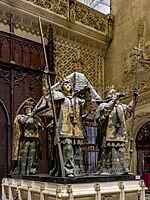
Many important people are buried in Seville Cathedral, including:
- Christopher Columbus
- Ferdinand Columbus (Christopher Columbus's son)
- Fernando III of Castile (King of Castile)
- Alfonso X of Castile (King of Castile)
- Pedro I of Castile (King of Castile)
Images for kids
-
Giralda as seen from the outside wall of the Patio de los Naranjos.
-
Gate to the Patio de los Naranjos, part of the old Almohad mosque, now annexed to the cathedral.
See also
 In Spanish: Catedral de Sevilla para niños
In Spanish: Catedral de Sevilla para niños


